This step by step diy project is about 16×16 lean to patio cover plans. This lean to has a 1.5:12 pitch and it can be both used as a carport or as a patio cover. If you want the second option, you can add some railings to the sides / front and you’ll get yourself a beautiful porch. Premium Plans also available in the Shop. Take a look over the rest of my woodworking plans, if you want to get more building inspiration.
When buying the lumber, you should select the planks with great care, making sure they are straight and without any visible flaws (cracks, knots, twists, decay). Investing in cedar or other weather resistant lumber is a good idea, as it will pay off on the long run. Use a spirit level to plumb and align the components, before inserting the galvanized screws, otherwise the project won’t have a symmetrical look. If you have all the materials and tools required for the project, you could get the job done in about a day.
Projects made from these plans
16×16 Lean to Patio Cover – PDF Download
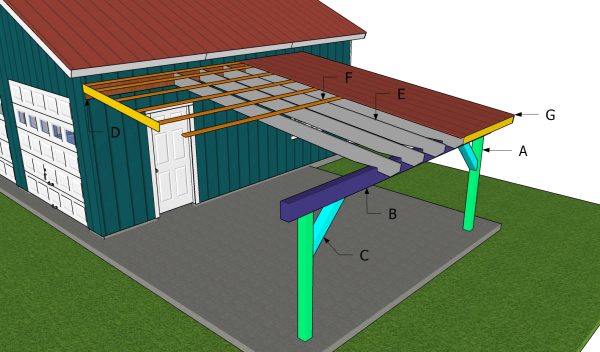
Building a 16×16 patio cover
Cut & Shopping List
Tools
![]() Hammer, Tape measure, Framing square, Level
Hammer, Tape measure, Framing square, Level
![]() Miter saw, Drill machinery, Screwdriver, Sander
Miter saw, Drill machinery, Screwdriver, Sander
![]() Concrete mixer, Post hole digger
Concrete mixer, Post hole digger
Time
Related
Building an attached carport – 16×16 DIY Plans
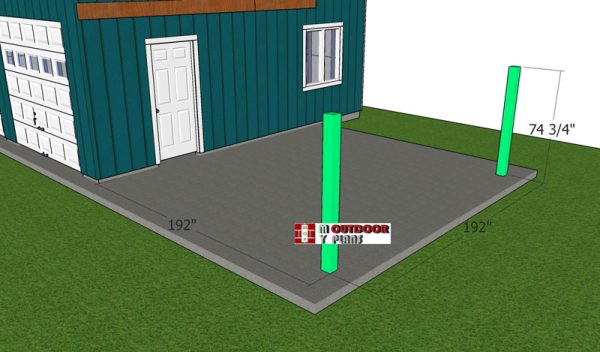
Laying-out-the-posts
The first step of the project is to set the 6×6 posts for the wooden attached carport. Use batter boards and string to layout the posts for the 16×16 carport.

Anchoring the posts of the anchor
You can set the posts in concrete or you can pour 3′ deep footings and use posts anchors. Considering this is a light outdoor project, you can set the posts to anchors. That is why, these plans are designed having that assumption in mind (concrete anchors).
Dig the holes and set the 14″ tube forms. Fill the tubes with concrete and set the post anchors. Make sure you let the concrete to dry out for a few day, before installing the posts into place. Use temporarily braces to secure the posts until you attach the plates.
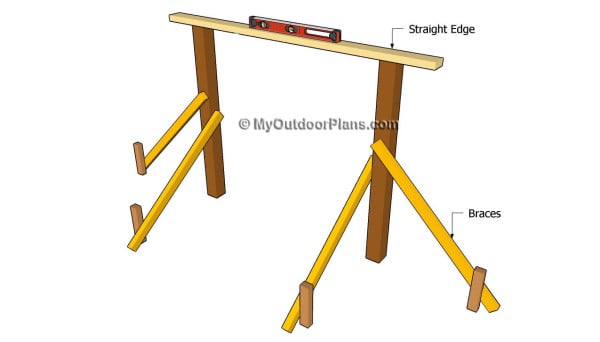
Installing the posts
Use a laser level / water level to make sure the top of the posts are at the same level.
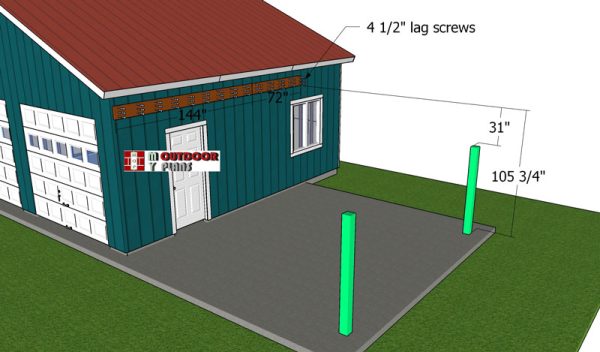
Fitting-the-ledger-boards
Next, we need to attach the 2×10 ledger to the house. Make sure you set the 2×10 ledger directly into the framing structure with 4 1/2″ lag screws with washers (or longer, depending to the house structure). Use a spirit level to check if the ledger is horizontal.
Drill pilot holes and insert the screws to lock it into place tightly (see your local codes for more info on how to secure the ledger). Insert 3 screws into each stud.
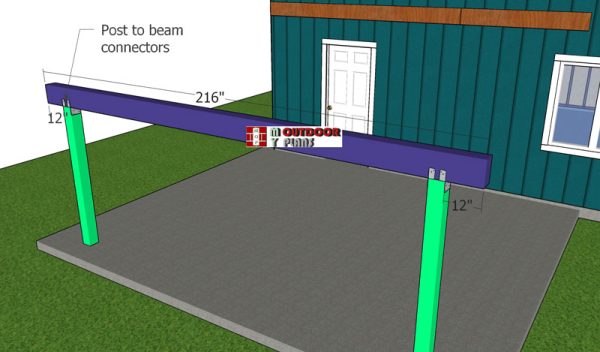
Fitting-the-top-support-beam
Continue the project by attaching the support beam to the top of the posts. See the 12″ overhangs on the sides. Plumb the posts and make sure the beams are horizontal. Use post to beam connectors to secure the beams to the top of the posts. Insert 1 1/2″ structural screws to lock the connectors into place.

Diagonal-Braces
Use 6×6 lumber for the braces. Make 45 degree cuts at both ends of the braces and then secure them into place with 5 1/2″ screws (at least 2 screws for joint).
Building the lean to roof
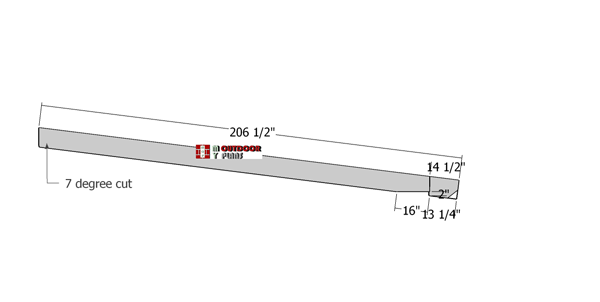
Rafters-for-16×16-lean-to
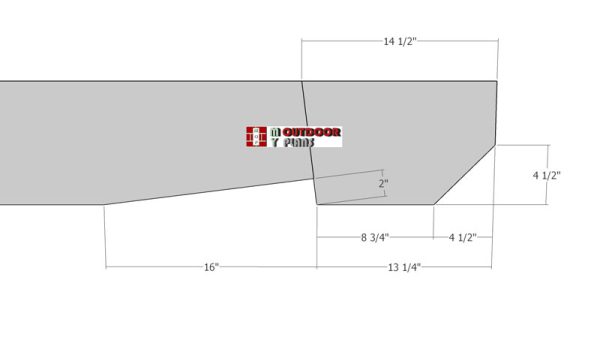
Rafter-end-cuts
Use 2×10 lumber for the rafters. Make a 7 degree cut to one end of the rafters. Mark the cut lines on the beams and then get the job done with a circular saw. Smooth the edges with sandpaper.

Attaching-the-rafters

Fitting-the-hangers
Fit the rafters to the attached carport, every 24″ on center. Fit the rafters to the ledger beams using rafter hangers and 1 1/2″ structural screws. Use rafter ties and 1 1/2″ structural screws to lock the rafters to the support beams.
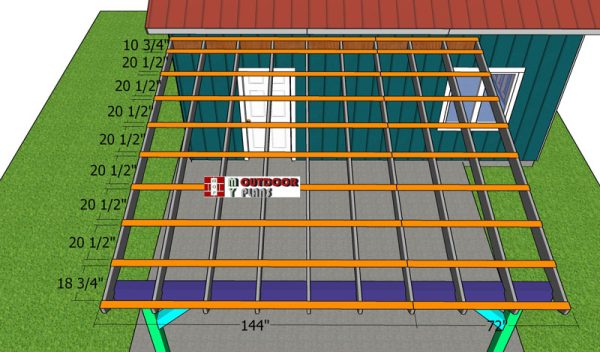
Fitting-the-purlins
Fit the 1×4 purlins to the top of the patio cover. Place the purlins every 24″ on center and secure them to the rafters with 2 1/2″ screws. We need these purlins so we can install the metal roofing sheets.
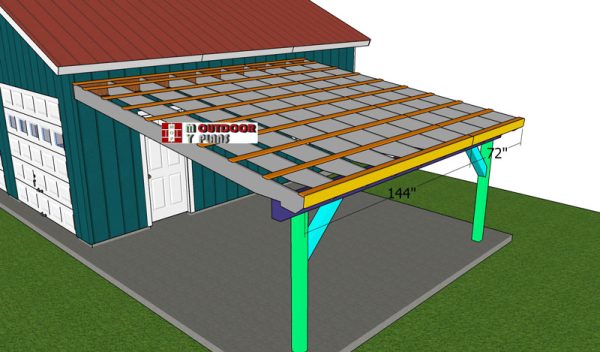
Fitting-the-end trims
Use 1×6 lumber for the roof trims. Align the edges flush and insert 2″ nails to lock them into place.
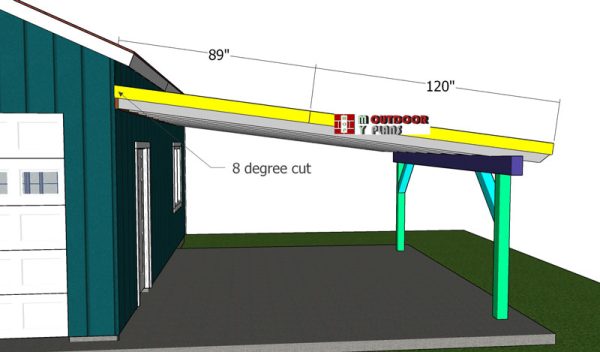
Side-trims
Cut and fit the trims to the sides of the carport. See the 7 degree cut to one end.

Installing-the-roof-flashing
In addition, install a flashing at the intersection of the roof to the wall. The flashing will waterproof the joint and prevent water leaks. Make sure you ask directions from the roof manufacturer, so you use the best solution to seal the wall to roof joint (see if it’s installed under or over the roof sheets).

Fitting-the-roof-sheets
Cover the roof with metal roof sheets. Install the drip edges along the side and front edges. Read the manufacturer’s instructions so you set the sheets into place with the appropriate screws and technique.
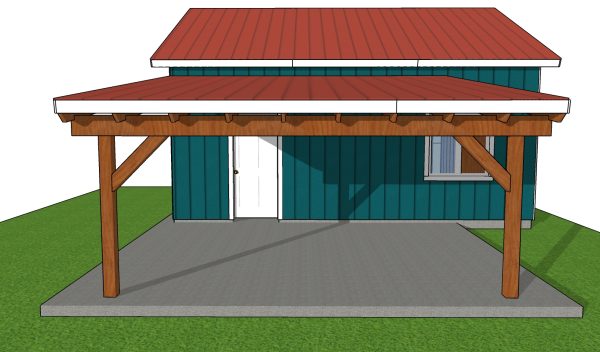
16×16 Attached Carport – front view
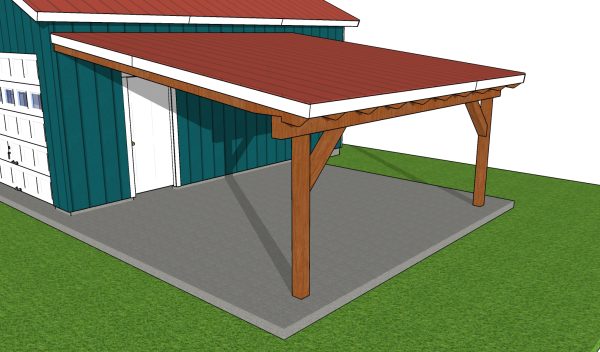
16×16 Attached Carport MOP
Last but not last, you need to take care of the finishing touches. Fill the holes with wood putty and let it dry for several hours. Smooth the surface with 120-220 grit sandpaper and apply a few coats of stain to enhance the natural look of lumber and to protect the components from the elements.

16×16 Attached Carport – side view
This project can be built in less than one week and it can also be used as a patio cover. I recommend you to read the local building codes before starting the project, so you make sure you comply with the local building codes. If you build this carport attached to the double garage, you will have a nice shaded area that will be perfect for a car or for woodworking outside. If you want to get the Premium Plans, see the GET PDF PLANS button bellow.
This woodworking project was about attached carport plans free. If you want to see more outdoor plans, check out the rest of our step by step projects and follow the instructions to obtain a professional result.

